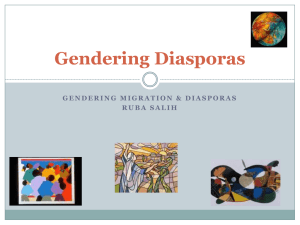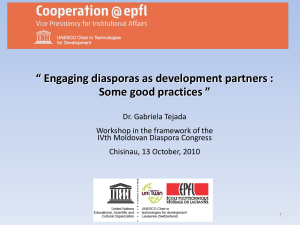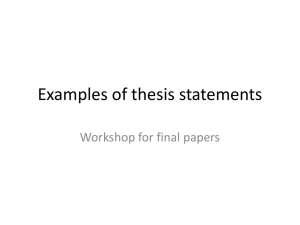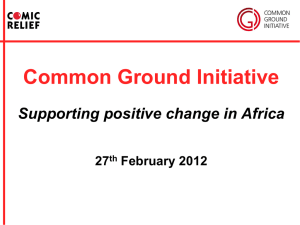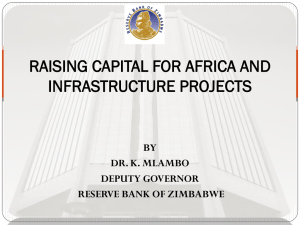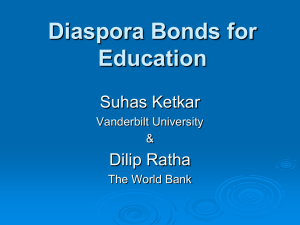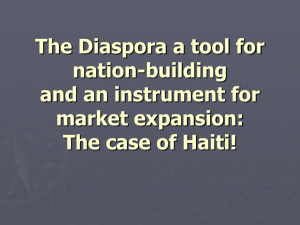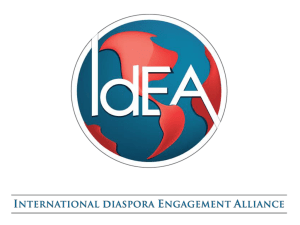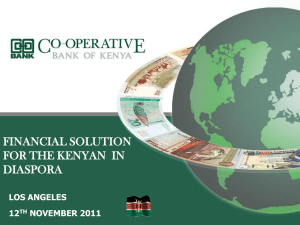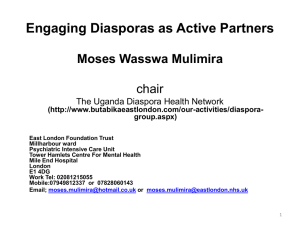Slide 0 - The Center for Migration Studies of New York (CMS)
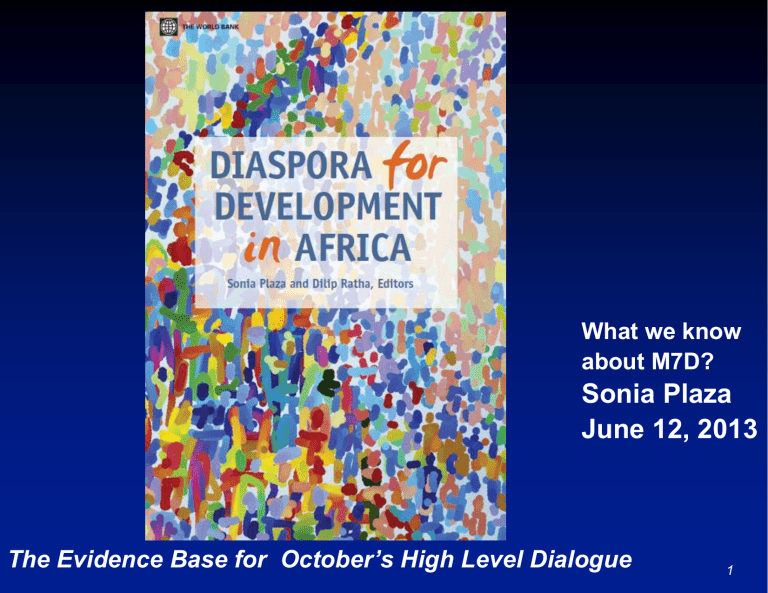
What we know about M7D?
Sonia Plaza
June 12, 2013
The Evidence Base for October’s High Level Dialogue
1
di·as·po·ra
noun \ dī-ˈas-p(ə-)rə, dē-\ the movement, migration, or scattering of a people away from an established or ancestral homeland
Key Messages
1.
Diaspora contributions are more than remittances.
2.
There are significant untapped economic benefits.
3.
Governments need to do more.
Outline
1.
Mapping of the diaspora
2.
Benefits of the diaspora :
A. Remittance inflow, support for poverty alleviation & philanthropic donations
B. Support for trade, technology and knowledge transfer
C. Investment by the diaspora
3.
Governments’ programs for engaging diaspora in sending and receiving countries
4.
Policy recommendations
African Union Definition of Diaspora :
"consisting of people of African citizenship and nationality and who are willing to contribute to the development of the continent and the building of the
African Union”
Diaspora Size: 2010
Millions
25
20
15
10
5
0
20
12
12
9
7
7
6
6
6 5 5 5
4
4 4 4
3 3
Ancestry in the USA: 2010
Million
48
35
26
20
17
10 9
5 5 4 4 4 3 3 3 2 2 2 2 2 2 1 1 1 1
Overseas Indians Living Abroad 2012
Overseas Indians: 21,909875
NRI: 10,037,761
PIO: 11,872,114
Ethiopia: Second Largest African migrants group in
USA thousands
211
140
133
111 110
85 84 81
67
40
N ig er ia
E th io pi a
E gy pt
G ha na
S om al ia
K en ya
M or oc co
S ou th
A fr ic a
Li be ri a
S ud an
Remittances
S KILLS
Investments
Benefits of engaging with the diaspora
A. Support for poverty alleviation and philanthropy
B. Support for trade, technology, and knowledge transfer
C. Investment by the diaspora
D. Potential for return
Remittances to developing countries to reach
$401 bn in 2012
Source : Development Prospects Group, World Bank
Philanthropic Activities by the African diaspora associations: Denmark case study
Other small-scale projects
9 (7%)
Health clinic projects
3 (2%)
School projects
13 (11%)
Information / education
20 (16%)
Larger programs
4 (3%)
Collective remittances
27 (22%)
Sending used equipment
Sending used equipment
41 (34%)
Sending new or larger equipment
(e.g. machines)
Donations / collective remittances
Education / capacity building / informational campaigns
School projects / orphanages / activity centers
Health clinics / hospital projects
Sending new equipment
6 (5%)
Other small-scale projects (wells
/ farming / micro-credit etc.)
Larger programs (education / environment / infrastructure)
13
Diaspora Organizations in USA
Organization Legal
Identity
Ethiopian
Orthodox
Church, DC
Objectives
Non-profit Promote education
Wegene
Ethiopia
Foundation,
VA
Coalition for
Ethiopia women for mutual support, NY
Non-profit Strengthening family structure
Non-profit Female empowerment
Funding Constraints
Fund raising, donations
Security during disaster relief, restrictions on imports
Membership, donations, collaboration s
Funding, information, legal system, taxes
Membership, donations,
New York assoc. for
New
Americans
Return migration, discrimination
Main findings of diaspora assoc.
In USA, associations still are self financed while in Denmark, external funding plays an important role
Opportunities in host country are important
Difficult for associations to access funds (e.g.,
SBA, or other European Funds)
Strong participation of diaspora for rebuilding post conflict and fragile states independently of place
(within Africa or outside Africa)
Main findings of diaspora assoc.
Level of contact with government varies by country:
– Liberia: strong connections with the associations
– Little contact or nil contact with governmental institutions (Nigeria, Kenya, Ethiopia). They work directly with schools and hospitals
Dual citizenship does not affect contributions
Support for Trade, technology and knowledge transfer
Source of demand for home country’s exports and linkages
A source and facilitator of research and innovation
Due to their cultural and linguistic abilities, they are better able to adapt, establish connections and reduce asymmetric information
Migration and Trade Go Hand in Hand:
African and OECD Countries
20
16
12
8
4
0
0 2 4 6 8 10
Log of migrant stock
12 14 16
Bilateral trade (2007) and migrant population (2010) between OECD and Africa
Each dot represents a migrant corridor (Kenya-UK, Morocco-France, etc.)
Technology and knowledge transfers
Licensing agreements
Direct investment in local firms as a joint venture
Knowledge spillovers (managerial positions)
Networks of scientists and professionals
Virtual return, extended visits or electronic communications
Return to permanent employment
Using the Diaspora to Supplement Local
Capacity
Global exchange of knowledge
Networks provide:
– A critical mass of professional peer review not available at the national level
– An effective mechanism for keeping in touch with the frontier of knowledge
– A cost effective means for specialized training and skills formation
Mentoring, internships, etc
Lessons from successful diaspora networks
Networks bring together people with strong motivation
Member play both roles:
– Implementing projects in the home country; and
– Serving as bridges and antennae for the development of projects in the home country
Migration as a driver of growth
ChileGlobal
China: How to foster innovation?
Research collaborations
Provide scientific input, key techniques, reagents to facilitate research projects, etc;
Help establishing research institute, centers,& laboratories that meet the US standards;
Joint laboratories with joint grants;
Joint biotech companies and joint fund raising activities
The Latin Scientific Diaspora
Not interested in “moving back”to their countries of origin
Most countries have failed in attracting them back
Not well organized
Very interested in helping their country of origin and or other Latin countries
LatIPnet has created own network of diaspora individuals
Scientists, directors, professionals, investors, lawyers
LatIPNet Mission and Charter
– To build value from knowledge in Latin countries by
Helping to build new global businesses using technology developed in Latin America and Spain
Helping to globalize tech business from Latin countries by bringing them into the US market
Enhancing the collaboration university-industry & building partnerships global players to bring value from R&D
– To educate Latin innovation agents on the value of
IP stressing commercialization and new venture generation
Examples of LatImPetu Companies
The Problem:
• Boom of tequila industry triggered overgrowth of agave plants through Mexico
• Agave grown outside the zones under “Designation of Origin” by the tequila industry could not be sold
• Price of agave plummeted
• Hundreds of agave farmers are going bankrupt while their agave plants are waisting in the fields. Losses are in the billions of dollars
The Solution:
Production of new, valuable, and global products (other than tequila) from the agave (i.e. natural sweeteners and food additives)
Brain Drain, Brain Gain or Brain
Circulation?
The dilemma of highly skilled migration
The special case of education and health professionals
Canada: Mitigate the brain drain by investing in diaspora-led development projects
High-skilled migration is larger in lowincome countries
Solution: train more people; leverage the diasporas
High-skilled emigration (of tertiary educated) from Small States
Emigration rate of tertiary-educated population
But migration can augment skill levels in developing countries through brain gain, skill and technology transfers, and return migration
Source: Migration and Remittances Factbook (2011).
High-skilled emigration (of tertiary educated) from Small States
Emigration rate of tertiary-educated population
But migration can augment skill levels in developing countries through brain gain, skill and technology transfers, and return migration
Source: Migration and Remittances Factbook (2011).
Virtual return and short term return
Virtual participation distance teaching, e-learning , joint research projects, peer reviewer
Remote resource mobilization (donation of books, sending computer, providing medical equipment)
Examples of facilitating conditions for returnees to the
Universities (flexibility in appointments, recognition of degrees, etc)
Information and identification of short-term return assignments
Access and acquisition of bandwidth for education and research purposes.
Investments in business and housing
30
20
10
60 Percent of total remittances
50
40
0
Senegal
Within
Africa
Senegal
Outside
Africa
Burkina
Faso Within
Africa
Burkina
Faso
Outside
Africa
Uganda
Within
Africa
Uganda
Outside
Africa
Business and other investments
Kenya
Within
Africa
Kenya
Outside
Africa
Nigeria
Within
Africa
Nigeria
Outside
Africa
Housing
The diaspora is more willing to take risks in its own country but…
They will need:
Conducive business environment
Sound and transparent financial sector
Rapid and efficient court systems
Safe working environment
Diaspora has savings that can be moblized
Diaspora resources are determined by the net wealth of members.
Types
– Diaspora bonds (India, Israel, Kenya,Ethiopia)
– Diaspora funds (Liberia is considering it)
Several countries show that diasporas do invest (e.g.,
China, Ethiopia, Kenya, India, Israel, Ireland)
The wealth of the diaspora can be mobilized through diaspora bonds
Developing countries
East Asia & Pacific
Europe & Central Asia
Latin America & Caribbean
Middle East & North Africa
Sub-Saharan Africa
South Asia
Diaspora size
(millions)
Estimated savings
($ billions, 2009)
161.5
21.7
43.0
30.2
18.0
21.8
26.7
397.5
83.9
72.9
116.0
41.2
30.4
53.2
The World Bank has set up a Task Force on Diaspora Bonds
Source: Ratha and Mohapatra 2011.
An important step is to know the profile of the diaspora
Mapping diaspora Profile
Mapping diaspora organizations and networks
Mapping existing obstacles to diaspora
Investments (e.g. dual citizenship, cost of visa, etc)
Boosting the development impact of the diaspora: selected policies
Objective
Mobilizing the diaspora
Stimulating ties with overseas communities
Measure
Dual citizenship
Virtual/temporary programs
Government invitations
Diaspora bonds
Foreign currency accounts (Bangladesh)
Premium interest rate accounts
Investment packages to overseas (China)
Establishing special office (Mexico)
Linking cooperatives/banks with banks in developed countries
Increasing domestic bank presence in transferring remittances
Saving mobilization: social security/housing/ microfinance programs
Stimulating investment
Outreach to migrant collectives/
Hometown associations (HTAs)
Improving attractiveness of receiving countries to diaspora
Outreach through MFI infrastructure
Outreach through migrant’s service bureaus
Tax breaks on imported capital goods
SME schemes (financial, infrastructure or innovative)
Training programs
Matched funding
Public-private ventures
Competitive bidding for development projects
Research funding and monetary incentives (Ireland)
Attractive salary packages, multiple-entry visas
Enabling migrants to spend on their relatives’ behalf
Government policies to
maximize the benefits of the diaspora
•
Policies in sending countries
• Dual/Multiple citizenship/Voting rights
• Conducive business environment/trade/tec
• Measures to quantify their diaspora
• Develop financial instruments to tap to the diaspora
• Portability of pension funds
• Management of Migration
•
Policies in receiving countries
• Acceptance of dual citizenship
• Agreement with other countries (social security portability, labor, taxation)
• Protection of immigrants
Examples of Initiatives in Africa (World
Bank)
Regional Initiative in Science and
Education (RISE) – Carnegie-IAS
– Origin: Vice Chancellors at Leaders’ Forum in
2006 concurred that staff development was their greatest need
– Objective: Prepare PhD-Level scientists and engineers in SSA through university research and training networks
– Diaspora role: giving short courses, hosting
RISE students at labs abroad, engaging in collaborative research
World Bank Initiatives
Program of engagement with the Africa Diaspora
– University of Ghana, Faculty of Social Science
– Ethiopia, Scholl of Medicine,
Telemedicine Unit, Connectivity
Develop joint curriculum
Thesis supervision, Mayo Clinic
– Support for diaspora initiatives (Kenya, Ethiopia,
Uganda, Mali, Tanzania, Liberia)
Focus groups and diaspora surveys
Jamaica
Comoros
Diaspora Bonds
AAU
Issues of Accreditation
ICT (bandwith)
Sensitizing faculty that it will be mutual collaboration (opportunities for joint research)
Institutional Affiliation
Providing back home opportunities
Communication and Access to Information
Governments have set up diverse initiatives to improve the image and knowledge of the diaspora by the members of the diaspora themselves as well as the general public.
Results:
Most embassies communicate via email notifications, websites, and through diaspora organizations.
All embassies have a website, but some have more detailed information.
Challenges
No government has complete mapping of diaspora; data mainly based on those who register with embassy
Very little involvement with investment, trade & technology transfer, few embassy staff dedicated to this:
At most, facilitate forums, or provide matching
Little coordination at the embassy/consular level when dealing with diaspora
Some instances of government mistrust by diaspora
Policy recommendations for governments
Data
• Improve data collection on diaspora
Improving diaspora outreach
• Embassies/foreign service departments need to provide more investment, trade, skills & technology transfer services, as well as more staff training in these areas
• Better coordination among different departments within the embassies and governments
Stimulating Investment
• Innovative ways of developing financing instruments, harnessing diaspora resources, etc
Key Messages
1.
Diaspora contributions are more than remittances.
2.
There are significant untapped economic benefits.
3.
Governments need to do more.
Thank you splaza@worldbank.org
www.knomad.org
